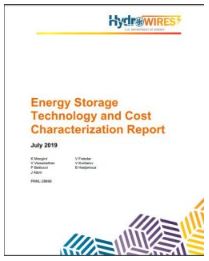A report recently released by the U.S. Department of Energy defines and evaluates cost and performance parameters of six battery energy storage technologies (BESS) and four non-BESS storage technologies.
The objective of this report is to compare costs and performance parameters of different energy storage technologies. Furthermore, forecasts of cost and performance parameters across each of these technologies are made.
The BESS technologies studied were lithium-ion batteries, lead-acid batteries, redox flow batteries, sodium-sulfur batteries, sodium metal halide batteries and zinc-hybrid cathode batteries. The non-BESS technologies studied were pumped storage hydropower, flywheels, compressed air energy storage and ultracapacitors.
Key findings include: •For a BESS with an E/P (energy to power) ratio of 4.0, Li-ion batteries offer the best option in terms of cost, performance, calendar and cycle life, and technological maturity.
•Pumped storage hydropower and compressed air energy storage, at $165/kWh and $105/kWh, respectively, give the lowest cost in $/kWh if an E/P ratio of 16 is used inclusive of balance of plant and construction and commissioning costs. Pumped storage hydro is a more mature technology with higher rates of round-trip efficiency.
•While the zinc-hybrid cathode technology offers great promise in terms of cost and life, its technology readiness level (TRL) and manufacturing readiness level (MRL) are both low at this stage.
•Redox flow batteries appear to be well positioned, and rapid improvements are expected in overall cost, performance, life, TRL, and MRL. While the round-trip efficiency for these batteries is low, there is room for improvement with stack optimization and better flow battery management algorithms.
•While lead-acid batteries are low cost with high TRLs and MRLs, their cycle life is limited, leading to a usable life of less than three years assuming one cycle per day.
•Sodium metal halide and sodium sulfur have similar cost and life characteristics, and metal halide technology has a higher round-trip efficiency. While the planar design for the sodium metal halide technology is expected to reduce cost, as is the substitution of sodium with nickel, uncertainty associated with these innovations led the research team to not build them into the 2025 forecast.
•For pumped storage hydro, compressed air energy storage, flywheels, and ultracapacitors, 2025 capital costs were assumed to be the same as those estimated for 2018. These are more mature technologies; hence this study assumed the 2025 costs to be unchanged. Further, pumped storage hydro and compressed air energy storage involve long-range development timelines and, therefore, a substantial reduction in costs is unlikely to be experienced in a relatively short number of years.
This report was completed as part of DOE’s Water Power Technologies Office-funded project entitled Valuation Guidance and Techno-Economic Studies for Pumped Storage Hydropower. The overarching project is ongoing as of the date this report was published and being performed by a multi-lab team consisting of staff from five national laboratories: the Argonne National Laboratory, Idaho National Laboratory, National Renewable Energy Laboratory, Oak Ridge National Laboratory, and the Pacific Northwest National Laboratory.
For full report see: https://www.energy.gov/sites/prod/files/2019/07/f65/Storage%20Cost%20and%20Performance%20Characterization%20Report_Final.pdf
